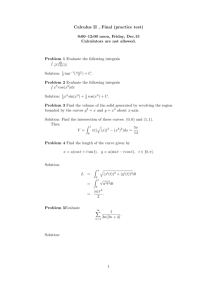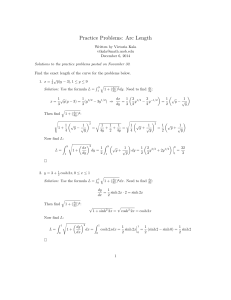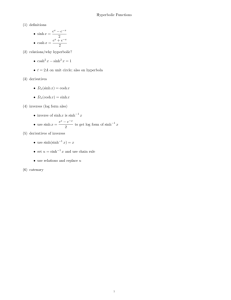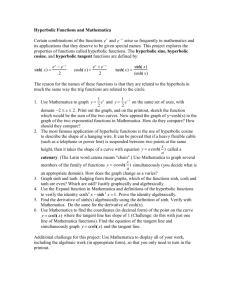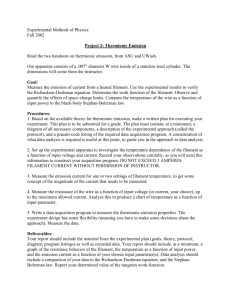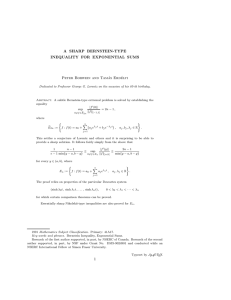08._IdealFermiSystems-2
advertisement
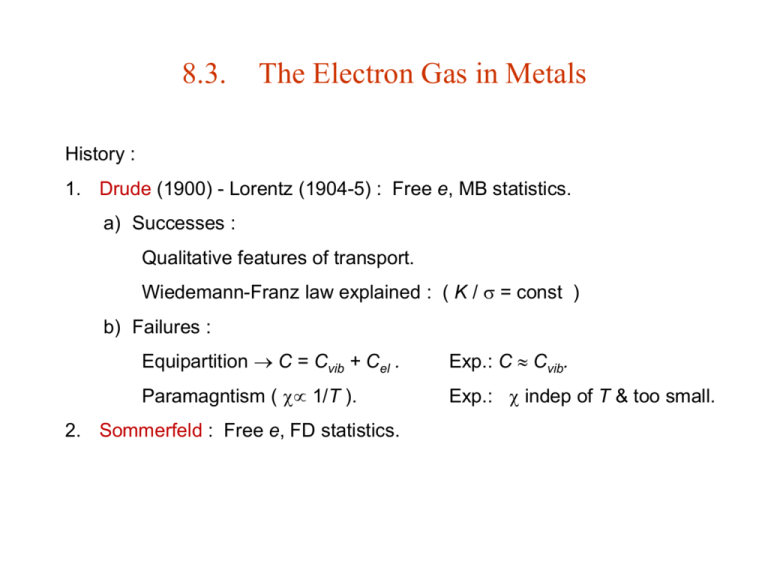
8.3. The Electron Gas in Metals History : 1. Drude (1900) - Lorentz (1904-5) : Free e, MB statistics. a) Successes : Qualitative features of transport. Wiedemann-Franz law explained : ( K / = const ) b) Failures : Equipartition C = Cvib + Cel . Exp.: C Cvib. Paramagntism ( 1/T ). Exp.: indep of T & too small. 2. Sommerfeld : Free e, FD statistics. Sommerfeld Theory g=2: F 2 2 m* Cubic lattice : Sodium (Na) : 3 n 2 n 2/3 m* = effective mass of e. nA = # of atoms per unit cell ne = # of electrons per atom a = lattice constant ( length of unit cell edge ) ne n A a3 ne 1, n A 2, a 4.29 A, m* 0.98me n 2.53 1022 cm3 TF F k Mathematica 3.72 104 K Troom 0.008 TF F 3.21 eV Ce 2 2 Highly degenerate Fermi system Nk kT F 3 102 N k 2 ~ few percents of Cclassical Low T : For Cu, CV Ce Cvib T T 3 D 343.8 0.5 K c.f. 345K from elastic constants. Intercept of CV / T vs T 2 with the vertical axis gives 0.688 0.002 mJ mole1 K 2 c.f. 0.69 from DOS calculation. Paramagnetism, Lorenz number are likewise improved . Thermionic & Photoelectric Electron Emission No spontaneous emission e in metal in potential well. Simplest model : square well Classically, only e’s with W U 0 p2 W such that u 2m inside metal outside 2m W can escape. m Low emission current Remaining e’s in quasistatic equilibrium. Treatment analogous to gas effusion . 8.3.A. Thermionic Emission ( Richardson Effect ) From § 6.4 : # of e emitted ( in the z > 0 direction ) per unit area per unit time is R 2 2 d px 3 d py 2 2 3 3 d pz 2 mW pz 2 m d p zm 2 mW e pz2 2 p 2m 2m e e pz2 2m x e 1 a 1e x 1 d ln 1 a e d x dx 1 x x 1 a e a e 1 1 x R kT 2 2 p2 z 2m d p p ln 1 e z z 2 mW 3 e p 1 1 1 dx 1 p2 p 2m 1 0 np pz np m pz d p z m 2 0 d p p 2 mW 2 2 p2 x 2m R kT 2 2 p2 z 2m d p p ln 1 e z z 2 mW 3 m kT R 2 3 2 pz2 z 2m z d ln 1 e z W z z F W F = Work function ~ eV ~ 104 K mkT R 2 3 2 d z W e z m kT W e 2 3 2 2 e m kT W J eR e 2 2 3 2 Thermionic current density : Boltzmannian e m kT W J e 2 2 3 2 J Classical statistics ( z << 1 ) : mkT 2 n 3z 2 2 g J classical n e n 3/2 g 3 f 3/2 z z k T W e 2 m work function W FD statistics ( z >> 1 ) : F class n e e m kT W F e 2 3 2 2 J FD W F FD k 2 m e m k2 2 2 120.4 A cm K 2 2 3 J classical class T e W J FD FD T e 2 W F ln J classical W class kT T Plot is straight line with slope W / k ln J FD W F FD T2 kT Plot is straight line with slope (W F ) / k e beam impinging on metal : outside h poutside h 2mE inside refractive index of metal for e’s is h pinside n h 2m E W outside inside W can be estimated from e diffraction experiments. W 13.5 eV for tungsten (W ) E W E ln ln J classical W class kT T Tungsten : = 4.5 eV J FD W F FD T2 kT Dotted Line : r = 0 Solid line : r = ½ For tungsten : W 13.5 eV, 4.5 eV, F 9 eV FD statistics For nickel : W 17 eV, 5.0 eV, F 11.8 eV Effects of reflection at surface : J (1r)J FD statistics Intercepts for most metal with clean surfaces range from 60 to 120 A cm2 K2 . c.f. FD 120.4 A cm 2 K 2 Schottky Effect Electric field surface : E F xˆ ( x = 0 at surface, x < 0 inside metal ) For an outside electron : Force from its image is f x e e xˆ 2 2x Setting U(0) =0 , the corresponding potential energy is x 2 e U Image x f x d x 4x x Potential energy due to E : U E x e F d x eFx By definition, potential energy of an inside e is . Potential energy of an outside e w.r.t. an inside one is e2 x eFx 4x e2 x eFx 4x e2 x eF 2 0 4x e2 x 3 0 2x x 0 xm e eF E lowers the barrier by e3/2 F1/2 . J F J0 e e eF Cold emission : xm 0 xm e 4F (xm) is a maximum 8.3.B. Photoelectric Emission ( Hallwachs Effect ) Condition for emission : m kT R 2 3 2 pz2 z 2m z h W Wh d z ln 1 e z z z F W h F can be ~ k T for x where z h W kT m kT R 2 2 3 h W h 0 kT kT 2 c.f. § 8.3A h W F d x ln 1 e x ( Non-Boltzmannian ) 0 0 W W F h h h m kT R 2 2 3 J eR J e m kT 2 2 3 2 x d x ln 1 e 0 2 x d x ln 1 e 0 x x d x ln 1 e x ln 1 e 0 0 h 0 kT e x x f e dx x d x 2 x x 1 e e 1 0 0 e m kT J f e 2 2 2 3 2 f e 2 2 e m kT 1 J 1 2 2 3 2 f e 1 e 2 e m kT 1 e m kT J0 1 2 J 0 2 2 3 2 24 3 2 Threshold = 0 : 2 e m kT e m kT h 0 / k T J e e 2 3 2 3 2 2 2 e m 0 2 h 0 kT 1 h 0 kT 1 2 2 6 Thermionic Pd ( = 4.97 eV ) 8.4. MOT : Ultracold Atomic Fermi Gas 2 a 3 2 0 0 1 2 3 1/3 N d a n FD 0 N 1 d e 2 3 F 2 0 3 d 2 0 3 1 F 0 6 N 1/3 3 F 7.5 1011 eV For 106 atoms in 100Hz trap : Ground state energy : U 0 F3 1 2 0 2 0 0 1 ( same as Bose gas ) F 1 2 0 3 d 0 3 TF 870 nK F4 1 2 0 3 4 U0 3 NF 4 U 1 d e 2 3 0 4U 0 kT 4 F 3 0 1 4 x3 0 d x z 1e x 1 U0 x T U 24 f 4 z U0 TF N 1 d e 2 3 0 3N F3 2 0 kT 1 3 x2 0 d x z 1e x 1 40K 3 T 1 6 f3 z TF 3 NF 4 F 0 6 N 1/3 0 4 x 1 f z d x 1 x 0 z e 1 1 See §11.9 for BCS condensation 3 F3 6N F4 8 U0 8.5. Statistical Equilibrium of White Dwarf Stars White dwarf stars ~ abnormally faint white stars. Reason: emitted light due NOT to fusion, but to gravitational contraction. Model : Star = Ball of He of M 1033 g , 107 gcm 3 , Tcenter 107 K kB Tcenter 900 eV k B 8.617 105 eV K 1 Mathematica Ionization energy of He : 24.6 eV, 54.4 eV me 9.109 1028 g, Ball = N e’s + ½ N (He nuclei) : mp 1.673 1024 g 1 M N me 4m p 2 N m p 2 n N M / 2m p 3 1030 cm3 2m p V M / dynamics of He ions negligible Model n 3 1030 cm 3 6 n pF g 2/3 6 2 n 5 8 10 eV F 2me g 2 me c 2 0.511 106 eV Tcenter 107 K 1/3 2 TF 5 1017 g cm s 1 F k 9 109 K e dynamics relativistic Tcenter 103 TF e gas completely degenerate Simplistic Model : Star = uniform, relativistic e gas Caution : n must varies for structural stability Ground State Properties N 2V 2 4 3 pF dp p mc 2 0 Relativistic particle : with rest mass m 2 2 3 pF3 3 p , p c 2 u p m pF p 1 mc = hamiltonian V 3 2n 1/3 p p mc 2 K mc mc 2 2 (g=2) 2 p2 c 2 p 1 1 mc p 1 p / mc 2 m me From § 6.4 : ( gas inside V ) 1 P0 n p u 3 0 1 V n 3 N 2 pF 3 dp p 0 p2 2 m 1 p / mc 2 N V 2 3 3 F p 3 p sinh mc p u 1 p / mc m uc 2 P0 sinh 1 sinh 2 3 pF 1 3 2 3 dp p 0 where 3 1/3 pF 2 x sinh F 3 n mc mc dp cosh d mc m 4c5 P0 3 2 3 F 4 d sinh 0 m u c tanh V mc V mc 3 3 N sinh F x 2 2 3 3 p2 2 1 p / mc 2 P0 m 4c5 P0 3 2 3 F d sinh 0 4 m 4c5 24 2 3 A x x sinh F pF mc F where A x 8 d sinh 4 x 2 x 2 3 1 x 2 3sinh 1 x 0 A x 0 8 5 4 7 1 9 5 11 35 13 x x x x x 5 7 3 22 208 5 35 7 A x 2 x 4 2 x 2 3ln 2 x 2 4 4 4 x 64 x Mathematica Equilibrium Configuration Adiabatic change of spherical volume : dE0 P0 n dV P0 R 4 R2 d R Accompanying gravitational energy change : d Eg Eg R dR GM 2 dR 2 R ~ 100 depends on the spatial variation of n. Equilibrium : d E0 d E g 0 GM 2 P0 R 4 R 0 2 R GM 2 P0 R 4 R 4 2 m 4c5 P0 24 2 3 A x x 3 n mc 2 1/3 A x x 2 x 2 3 1 x 2 3sinh 1 x m me GM 2 P0 R 4 R 4 Equilibrium condition : M 2 Nm p 1/3 2 N x 3 4 mc 3 R 3 4 5 mc 24 2 3 A m Equilibrium condition : ( Mass-radius relationship ) mc 1011 cm 1/3 9 1 N R mc 4 9M c 8 m p A m 9M m c 8 m p 1/3 1 R 1/3 GM 2 1 R 4 4 R 9M c 8 m p 1 R 6 1/3 = Compton wavelength of electron 3 GM 2 mc R mc 2 R QM+SR+Gr A m 9M c 8 m p 1/3 1 R 6 9M x m c 8 m p 3 GM 2 mc R mc 2 R 1/3 1 5 108 cm R 1 R A x 1. R >> 108 cm ( x << 1 ) : 1/3 9 3 2 R 40 M 9M R m c 8 m p M M0 Mathematica for M = 1033 g 8 5 x 5 2 m m 5/3 p M 1/3 A x 2 x4 2 x2 2. R << 108 cm ( x >>1 ) : A x x 2 x 2 3 1 x 2 3sinh 1 x 1/3 M 1 M 0 as observed 2/3 M0 9 3 64 c G Chandrasekhar limit : e M 2 N mp 3/2 m p2 1033 g M0 5.75 e2 M M0 Star collapse into neutron star or black hole Influx from companion binary star Type Ia supernovae (see Chap.9) 8.6. Statistical Model of the Atom Thomas-Fermi model : 1/2 For a completely degenerate e gas 6 2n pF 2 Let the gas be under a Coulomb potential (r). For slowly varying n : pF r 3 2n r Energy of e at top of Fermi sea : 1/3 pF2 r r e r 2m At boundary of system, pF = 0 & we can set = 0 so that = 0. pF2 r r e r 0 2m r pF r 3 n r 2 1 p r n r 2 F 3 Poisson eq. : 3 1 2m 2 2 e r 3 pF2 r e r 2m 1/3 3/2 2 r 4 r 4 e n r 4 e 2m r e r 3 2 3/2 2 4 e 2m 1 d 2 d r r e r Spherical symmetry : 2 3 2 r d r d r 3/2 ThomasFermi eq. 4 e 2m 1 d 2 d r r e r 3 2 r 2 d r d r r Let Set 3/2 r Ze / r d d d 2 d d 2 r r Ze dr dr d r2 dr dr 1 d d Ze 2 dr r dr r 1 d 2 d Ze d 2 r 2 r d r d r r d r2 d 2 3/2 1/2 2 dx x 2 3 Ze d x d x2 4 e 2m Ze 2 3 2 x 4 e 2m 2 Ze 2 Ze 3 3/2 x r 3/2 3 Dimensionless T-F eq. 4 3 2/3 2m e 2 2 1/3 Z Z 1/3 0.88534 aB aB 2 me2 Bohr radius r r d 2 3/2 1/2 d x2 x Ze / r Z 1/3 x r 0.88534 aB B.C. : Ze r r For x , r 0 : For x , r r0 (boundary) : r 0 0 1 ( neutral atom ) x0 0 For r0 : x 0 1 1.5886 x x 3 x 10 1 144 x 144 x3 4 3/2 x 3 1 / 73 7 0.257 6 Sommerfeld, Z.Physik 78, 283 (32) Complete solution tabulated by Bush & Caldwell, PR 38,1898 (31) 1 2m n r 2 2 e r 3 n r 3/2 r r 4 Z e 1 3/2 Z 4 dr r n r Z 3/2 dr r x r r r 1/2 3/2 r 0 0 4 3 Ze / r 2 Z 4 r 3/2 Z 1/2 3/2 d x x x 0 1/2 3/2 d x x x 1 0 Z 1/3 0.88534 aB 1 1 Ze r r Z 3 Z 4/3 r Z n r 4 r r 2/3 3/2 Z 1 13 1 3 32 Z2 2m e 2 2 Z1/3 Radial Distribution Function D r 4 r 2 n r Hg atom Z dr D r 0 Actual T-F a 2 me 2 pF r 3 2n r Binding Energy Mean ground state K.E.: 1 2V 4 N 2 3 pF2 r e r 2m pF 2 2 p 0 dp p 2m pF5 10m 1 n2 3 Total ground state P.E.: 3 3 5 r e r Total ground state K.E.: 1 pF F 3 F r n2 5 5 K0 4 dr r 2 n r r 0 3 e 4 5 2 dr r n r r 0 Ze Ze 1 U 0 4 dr r 2 n r e r r r 2 0 nuclei other e’s cancels double counting Total ground state E: E0 K0 U 0 1 1 Z e2 4 dr r n r e r 10 2 r 0 2 1/3 1 1 Z e2 2 E0 4 dr r n r e r 10 2 r 0 1 2m n r 2 2 e r 3 3/2 E.Milne, Proc.Camb.Phil.Soc. 23,794 (1927) : 1.5886 e2 7/3 1 E0 Z 1 0.88534 2aB 7 E B E0 1.538 Z Binding energy : 7/3 e2 13.6 eV 2a B EB of H atom E0 Z 7/3 Z 4/3 N Z E0 Z 7/3 4 3 2/3 2m e 2 2 Classical regime : 1/2 Z 2/3 Linear size of e cloud l 1 Z1/3 Z1/3 h E 0 p N l Z 2/3 Z 1/3 Z 1

